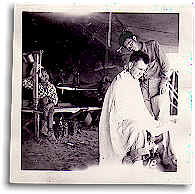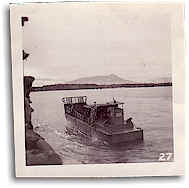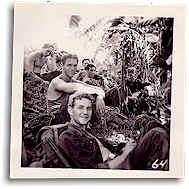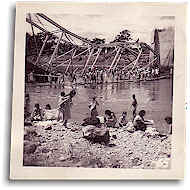|
"TRIUMPH IN THE
PHILIPPINES"
(The Role of the 503d PRCT
in Northern Negros)
_________________
Robert Ross Smith

1 | 2
| CORREGIDOR

Map 30
Clearing the Central Visayan Islands

Chet Targonski gets a haircut whilst
the
Filipino barber's wife looks on.

An LCM comes alongside. Mt. Silay is in the background.

Bell, Eisenbraun, Norelli, Dennis, Spofford and Duda take a break in a
banana grove.

The bridge over the Himagaan River at Fabrica, Negros Occidental. |
After the completion of the Corregidor operation, the 503d PRCT returned
to its former camp on Mindoro. The explosion at Monkey Point had
effectively rendered the first battalion unable to function as a
fighting outfit, and it needed time to be rebuilt from the influx of new
replacements. So too the other battalions and companies also carried the
battle scars of the losses of experienced officers, leaders, and
'troopers.
Those
who had survived Corregidor physically unscathed,
were photographed in a series of
States of Enlistment images.
With
implications perhaps unnoticed at the time, the control of the 503d PRCT
now passed from under the control of Gen. Kruger's Sixth Army to the
Gen. Eichelberger's Eighth Army. The latter had not been thought
of highly by many in the 503d, but orders were orders.
Negros lay ahead, and it would be every bit as bad, and probably worse
than Corregidor - the 503d PRCT were lightly armed, and on Negros,
poorly supported and at the far end of the 40th Division's supply chain.

The Central Visayan Islands
Northern Negros
On
24 March General Eichelberger, the Eighth Army's commander,
decided that operations on Panay had proceeded to the point
where the 40th Division could move against northern Negros and
set 29 March as the date for the new attack.5
The
185th RCT would make the assault; the 160th RCT (less the 2d
Battalion, 160th Infantry) would follow on 30 March.6
The
503d Parachute RCT, staging at Mindoro, would jump to reinforce
the 40th Division upon orders from Eighth Army. Eighth Army
reserve for the operation was the 164th RCT, Americal Division,
on Leyte. The 40th Division could expect help from Negros
guerrillas under Colonel Abcede since, with about 14,000 troops,
over half of them armed, Abcede controlled two-thirds of the
island.
Lt. Gen. Takeshi Kono, commander of the
77th
Infantry Brigade, 102d Division,
had
around 13,500 men in northern Negros.7 Another
1,300 Japanese were concentrated at the southeast corner of the
island but, tactically unrelated to Kono's force, reported to a
headquarters on Cebu. Kono commanded about 5,500 men of the102d
Division,7,500
troops of the 4th Air
Army's 2d Air Division, and
500 naval personnel. The trained combat effectives, about 4,000
in all, were from the 102d
Division.8Kono's troops
lacked many essential items of supply. For example, less than
two-thirds of his men were armed--he had only 8,000 rifles.
Small arms ammunition was far from adequate; food, assuming no
losses, could last for little more than two months. On the other
hand, in some respects the Japanese were very well armed. Home
of the
2d Air
Division,
northern
Negros had bristled with antiaircraft weapons, which Kono could
use for ground operations. Kono's troops had also remounted
numerous automatic weapons taken from
2d
Air Division
planes
destroyed or damaged on the northern Negros fields.
Like Japanese
commanders elsewhere in the Philippines, Kono did not plan to
defend the most important ground under his control, the airfield
area of the northwestern Negros coastal plain. He intended to
withdraw into the mountains of north-central Negros for a long
stand, leaving only token forces behind in the coastal plain to
delay American penetrations and to destroy bridges and supplies.
In late March, accordingly, the bulk of his forces were on their
way to inland positions, but unfortunately for Kono he was
unable to take many of the larger antiaircraft guns with him.9Kono's
first defense, an outpost line of resistance, extended along the
foothills of the mountains generally seven miles inland (east)
from Bacolod, twenty-five miles east across Guimaras Strait from
Iloilo. His main defenses lay five to six miles deeper into the
mountains.
The 40th Division's
first landing on Negros took place about 0500 on 29 March when a
reinforced platoon of Company F, 185th Infantry, went ashore
unopposed in the vicinity of Pulupandan, fifteen miles south of
Bacolod. The platoon moved directly inland about three miles to
secure a bridge over the Bago River, a bridge that provided the
best and closest means of egress from the Pulupandan area to the
Bacolod region. Clashing sharply with Japanese bridge guards,
the platoon seized the Bago span before the guards, caught by
surprise, could set off prepared demolitions. The platoon then
held the bridge against minor counterattacks until relieved
about 0930 by the main body of the 185th Infantry. The 185th had
begun landing at Pulupandan about 0900. There was no preliminary
naval bombardment and there was no Japanese resistance.
Spreading northward
and eastward the 185th Infantry, which the 160th followed,
secured almost the entire coastal plain of northwestern Negros
by noon on 2 April at the cost of approximately 5 men killed and
10 wounded. By evening on the 8th the two regiments had
overrun the Japanese OPLR and were readying an attack toward
Kono's inner fortress. Meanwhile, no need for the 503d Parachute
Infantry to jump on Negros having developed, the regiment had
flown from Mindoro to Panay and moved to Negros aboard small
craft. Assembling to the left of the 185th Infantry (the 160th
was now on the 185th's right), the parachute regiment prepared
to participate in the attack against Kono's main defenses.
|
|
   |
|
|

|
|
|








